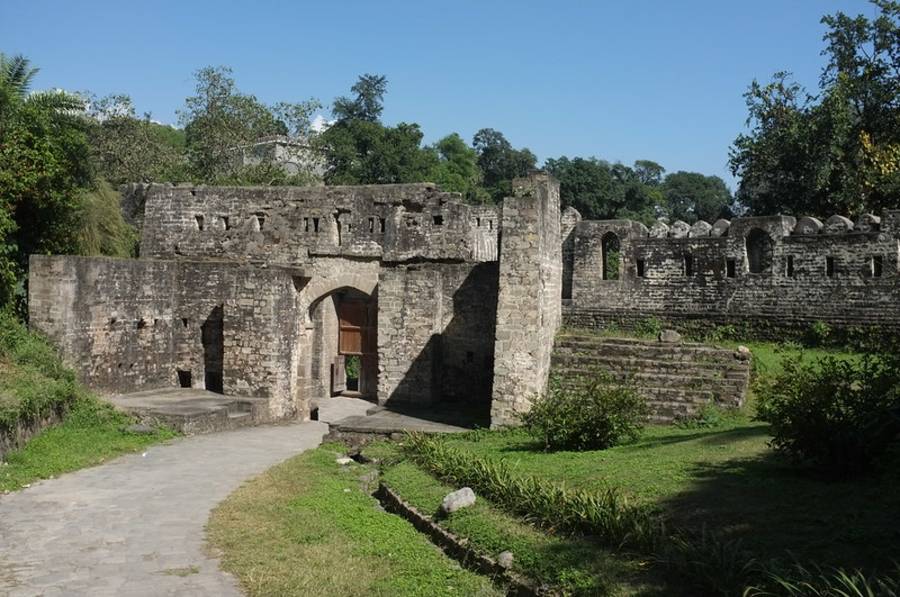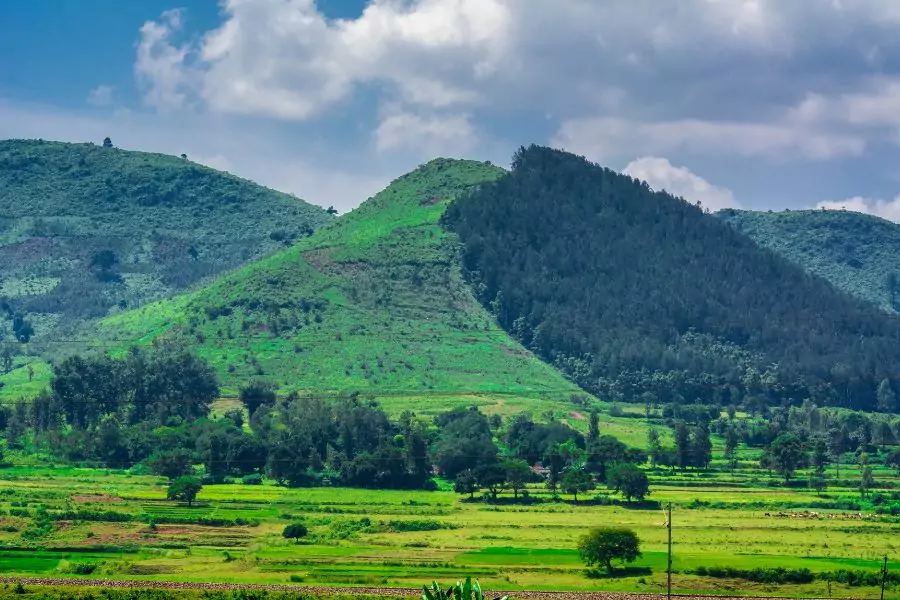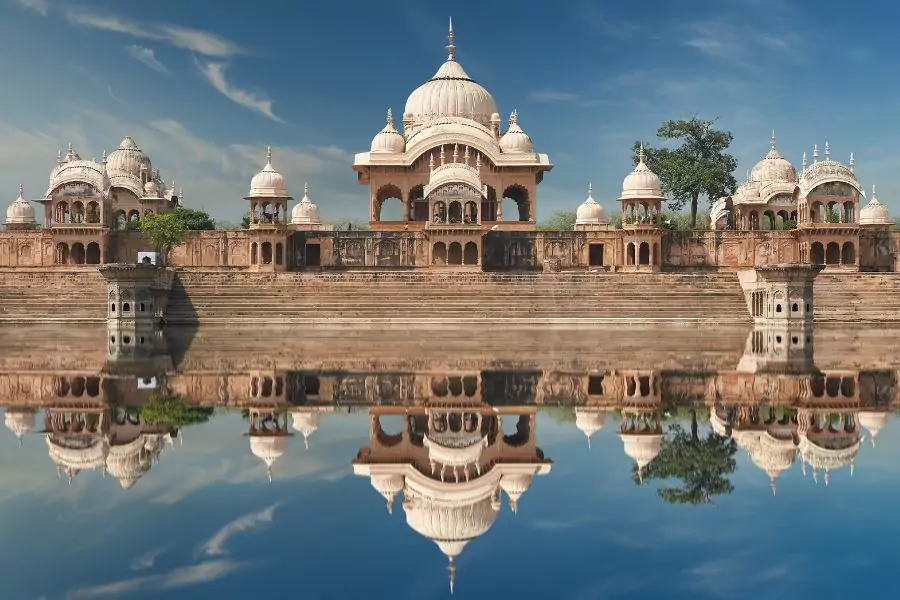Kangra Fort
Exploring Kangra Fort of Himachal Pradesh
Strap on your sneakers, grab a bottle of water, and prepare for a climb, unlike any other fort in Himachal Pradesh. Roughly 20 km from the well-known town of Dharamsala, Kangra Fort lies in the southwest corner of Kangra town, a quiet reminder of a fort that once dominated this region. The impregnable looking fort is perched high atop a steep cliff looking down onto the confluence of the Manjhi and Banganga Rivers, inaccessible from 3 sides. As the oldest fort in the North Indian state of Himachal Pradesh, its fate was sealed not by the many battles it endured or the series of rulers it housed but ultimately by a massive earthquake in 1905 which leveled most of the building.
Visitors gain access to Kangra Fort through a small courtyard before reaching a gate built during the Sikh ruling era; a period dating from 1809 to 1846 before the British conquered the Kangra Valley fort. This gate sealing the 4 km outer wall encircling KangraFort, is known as Ranjit Singh Gate, aptly named after the conquering Sikh maharaja. A second gate known as Jehangir gate, named in homage to Mughal Emperor Jehangir, who seized Kangra Fort from Muslim rulers in 1621, leads to a long narrow staircase passage ascending to the fort. Hand-carved idols embossed within the stone walls as well as the halfway Anahi and Amiri gates are rich with photo opportunities and provide pause for tourists along the cobbled pathway. The Jehangir Gate coupled with the Amiri gate was repairable after the 1905 earthquake. Moving beyond this point is where the quake’s devastation took its greatest toll.
A path of rocky ground leads to Andheri Darwaza and Darsani Darwaza, the final two gates within the Kangra Fort complex. What exists within the top layer of the fort is a mixture of stone ruins surrounded by natural overgrowth. Every corner appears to be occupied by steps leading somewhere, anywhere. A stone courtyard holds center stage from where curious guests can mark a return to catch their bearings. Former royal residences are nearly indiscernible among the many crumbling walls marked by staircases leading to doorways that no longer hide their inner contents. Fallen stones have been collected by someone, at some point, stacked as if fresh inventory had arrived to rebuild the mighty fortress. Yet they lie among the grassy yard, next to treetops overlooking the river banks below waiting for the next monsoon season, the next winter to slowly erode another year off their life.
Two temples, the Lakshmi Narayan Mandir and Shaitala Mandir are notable sites to view aside from what is considered a hidden mosque located a little distance from the Darshani Gate. Continue higher to the upper levels of Kangra Fort to find the watchtower. Breathtaking views of the surrounding Himachal Pradesh Kangra Valley reward those who climb to the peak.
Maharaja Sansar Chandra Museum, adjoining Kangra Fort, provides audio guide services for tourists who crave a further understanding of the National Monument. Numbered stops scattered throughout the complex give further details into the historical background of this little-mentioned property in India guidebooks. And the museum houses an extensive collection of items helping to give a sense of how regal Kangra Fort was just a few hundred years past.
History
Kangra Fort is a historic fort located in the town of Kangra in the Indian state of Himachal Pradesh. It is one of the oldest and largest forts in India, and is believed to have been built by the ancient Trigarta Kingdom. The fort has a rich history, and has been ruled by various dynasties over the centuries.
The earliest records of the fort date back to the 4th century BC, when it was known as the Bhima Kali Temple. According to legend, the fort was built by the Pandavas during the Mahabharata era. In the 10th century AD, the fort was ruled by the Katoch dynasty, who were known as the rulers of the Kangra region. The Katoch rulers made significant additions to the fort, including the construction of the Sheesh Mahal, the Diwan-i-Khas, and the Diwan-i-Am.
In the 16th century, the fort was invaded by the Mughal emperor Akbar, who seized control of it after a fierce battle. The fort was later recaptured by the Katoch rulers in the 17th century, and was ruled by them until the 19th century. During this time, the fort underwent further renovations and additions, including the construction of the Jahangir Mahal.
In 1846, the fort was seized by the British East India Company after the conclusion of the First Anglo-Sikh War. The fort remained under British control until India gained independence in 1947.
Today, Kangra Fort is a popular tourist attraction and is known for its impressive architecture and historical significance. The fort was damaged by an earthquake in 1905, but has since been restored. It is now a protected monument under the Archaeological Survey of India.
Time
Plan on 1.5 – 2 hours to properly view the fort and museum.
Location
Kangra Fort is located in the town of Kangra, in the Kangra district of the Indian state of Himachal Pradesh. It is situated on top of a hill overlooking the Banganga and Majhi rivers, and is about 20 kilometers from the city of Dharamshala.
How to Reach
Kangra Fort is easily accessible by road, rail, and air.
By Road: The town of Kangra is well-connected by road to major cities in the region. Buses and taxis are available from cities like Dharamshala, Pathankot, and Chandigarh.
By Rail: The nearest railway station to Kangra Fort is the Kangra Railway Station, which is located about 5 kilometers away. The station is well-connected to major cities in the region, and taxis and auto-rickshaws are available from the station to the fort.
By Air: The nearest airport to Kangra Fort is the Gaggal Airport, which is located about 15 kilometers away. The airport is well-connected to major cities in the region, and taxis and buses are available from the airport to the fort.
Once you reach Kangra town, you can take a local taxi or auto-rickshaw to reach the fort. The fort is situated on top of a hill, and there is a steep climb to reach the entrance. Visitors can either climb the hill on foot or take a taxi or auto-rickshaw to reach the entrance gate.
What to See
Bajreshwari Devi Temple is a popular pilgrimage site and is considered one of the most renowned shrines in North India.
Where to Stay
Kangra Fort is a popular tourist attraction in Himachal Pradesh, known for its impressive architecture and historical significance. Some of the major attractions to see at the fort include:
- Sheesh Mahal: The Sheesh Mahal is a stunning palace within the fort, known for its intricate mirror work and impressive architecture.
- Diwan-i-Khas: The Diwan-i-Khas is an open-air pavilion within the fort, where the Katoch rulers held meetings and conducted official business.
- Diwan-i-Am: The Diwan-i-Am is a large hall within the fort, used for public audiences and other official events.
- Temples: There are several temples within the fort, including the Ambika Devi Temple, Lakshmi Narayan Temple, and Shitla Mata Temple.
- Jahangir Mahal: The Jahangir Mahal is a palace within the fort, built during the reign of Mughal Emperor Jahangir.
- Museum: There is a museum within the fort, which houses various artifacts and exhibits related to the history of the fort and the region.
- Viewpoints: Kangra Fort offers stunning views of the surrounding hills and valleys, and there are several viewpoints within the fort that offer panoramic views.
Overall, Kangra Fort is a must-visit destination for history and architecture enthusiasts, as well as those looking for a scenic and peaceful place to visit.



